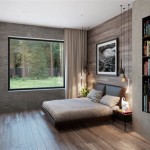How to Determine Your Interior Design Style
Identifying one's interior design style can feel like an overwhelming task, given the multitude of options and influences available. A well-defined interior design style provides a cohesive aesthetic for a home, reflecting personality and creating a comfortable and functional living space. The process of pinpointing a style requires introspection, observation, and a willingness to experiment. This article will outline practical strategies for discovering and refining personal design preferences.
1. Self-Assessment and Inspiration Gathering
The initial step in determining an interior design style involves a thorough self-assessment. This process necessitates examining personal preferences, lifestyle, and functional needs. Consider existing belongings. Are there recurring patterns, colors, or textures in the current wardrobe, artwork, or decorative items? These existing preferences offer clues about aesthetic inclinations.
Beyond existing possessions, reflect on experiences. Which environments evoke feelings of comfort, joy, or relaxation? Consider past travels, favorite hotels, or memorable homes visited. Note the design elements present in these spaces – color palettes, furniture styles, architectural details, or spatial arrangements. These elements can provide valuable insights into preferred aesthetics.
Another crucial aspect of self-assessment involves evaluating lifestyle. A minimalist lifestyle, for instance, might align with modern or Scandinavian design, emphasizing clean lines and functionality. Conversely, a lifestyle centered around entertaining might favor a more opulent and inviting style, such as traditional or bohemian, with ample seating and decorative accents. Consider practical needs as well. Households with children or pets may require durable, easy-to-clean materials and furniture arrangements that prioritize safety and accessibility. Identifying these practical requirements will help narrow down design options.
Simultaneously with self-assessment, begin actively gathering inspiration. The digital age offers a wealth of visual resources. Online platforms like Pinterest, Instagram, and Houzz provide vast collections of interior design images. Create mood boards, either physical or digital, by curating images that resonate visually. Pay attention to recurring themes within these images. Do they feature specific color combinations, furniture shapes, or architectural styles? These recurring elements point towards potential design preferences.
Traditional media also serves as a valuable source of inspiration. Interior design magazines, books, and television shows offer in-depth explorations of various styles. These resources provide not only visual inspiration but also educational insights into the history, principles, and key elements of different design styles. Visiting show homes or attending design fairs can provide firsthand experience of different styles and allow for direct interaction with design professionals.
2. Exploring Different Interior Design Styles
Once a collection of inspirational images and insights from self-assessment is gathered, the next step involves exploring different interior design styles. Familiarize yourself with the defining characteristics of common styles to identify potential matches with personal preferences. Several prevalent styles exist, each with distinct features. Understanding these styles is crucial for making informed decisions.
Modern Design: This style emphasizes clean lines, minimalism, and functionality. Modern interiors typically feature neutral color palettes, open floor plans, and natural materials such as wood, glass, and metal. Furniture is often sleek and geometric, with minimal ornamentation. Modern design prioritizes simplicity and efficiency.
Contemporary Design: Often confused with modern design, contemporary design is more fluid and evolving. It incorporates elements from various eras while maintaining a sense of current trends. Contemporary interiors often feature curved lines, textured fabrics, and bold accent colors. Sustainability is a key concern, with an emphasis on eco-friendly materials and energy-efficient appliances.
Traditional Design: This style draws inspiration from historical periods, such as the Victorian, Georgian, and French Provincial eras. Traditional interiors feature ornate details, rich colors, and classic furniture styles. Fabrics like velvet, silk, and brocade are commonly used, and accessories such as antique mirrors, chandeliers, and formal artwork are prevalent.
Minimalist Design: This style is characterized by extreme simplicity and a focus on essential elements. Minimalist interiors feature sparse furnishings, neutral color palettes, and a clutter-free environment. Every object is carefully considered and serves a specific purpose. Minimalism emphasizes functionality and a sense of calm.
Scandinavian Design: This style blends simplicity, functionality, and natural elements. Scandinavian interiors feature light wood tones, neutral colors, and an abundance of natural light. Furniture is typically functional and comfortable, with clean lines and minimal ornamentation. Cozy textiles, such as sheepskin rugs and wool blankets, are often used to add warmth.
Bohemian Design: This style embraces eclecticism, individuality, and a free-spirited aesthetic. Bohemian interiors feature a mix of patterns, textures, and colors. Furniture is often vintage or secondhand, and accessories include global textiles, plants, and personal collections. Bohemian design prioritizes comfort and self-expression.
Industrial Design: This style draws inspiration from factories and warehouses. Industrial interiors feature exposed brick, concrete floors, and metal accents. Furniture is often functional and utilitarian, with a focus on raw materials and vintage elements. Industrial design embraces a sense of rawness and authenticity.
Beyond these common styles, numerous other variations exist, such as coastal, farmhouse, mid-century modern, and art deco. Explore these different styles through online resources, magazines, and books. Identify the elements within each style that resonate positively and note any aspects that seem unappealing. This process of exploration and elimination will help narrow down the options.
3. Combining and Refining Preferences
Few individuals adhere strictly to a single interior design style. More often, personal preferences involve a blend of different styles, creating a unique and personalized aesthetic. The final step involves refining these preferences and creating a cohesive design plan.
Identify the common threads among the inspirational images and preferred design elements. Are there recurring color palettes, furniture styles, or spatial arrangements? These commonalities represent the core elements of the personal design style. Consider how these elements can be combined to create a harmonious and functional living space.
Experiment with different combinations of styles. A modern interior, for example, can be softened with Scandinavian-inspired textiles and natural elements. A traditional interior can be updated with minimalist accents and a contemporary color palette. The key is to find a balance that reflects personal preferences while maintaining a sense of cohesion.
Create a detailed design plan, including a color palette, furniture selection, lighting plan, and accessory choices. This plan serves as a roadmap for implementing the chosen design style. Consider using design software or online tools to visualize the space and experiment with different layouts.
Before making any major purchases or renovations, test the design plan on a smaller scale. Start with a single room or a specific area within the home. This allows for experimentation and adjustments without committing to a large-scale project. Pay attention to how the space feels and functions. Do the chosen colors and furniture arrangements create the desired atmosphere? Are there any practical issues that need to be addressed?
Flexibility and adaptation are crucial throughout the design process. Personal preferences may evolve over time, and practical considerations may necessitate adjustments to the original plan. Be willing to experiment, adapt, and refine the design style until it accurately reflects personal preferences and creates a comfortable and functional living space. Consulting with an interior design professional can provide valuable guidance and expertise throughout the process, ensuring a cohesive and aesthetically pleasing outcome.

Dear Urbaneer How Do We Establish Our Interior Design Style

How To Figure Out What S My Design Style Worthing Court

How To Find Your Unique Personal Interior Design Style Dwell Beautiful

Find Your Interior Design Style Quiz Southern Motion

A Guide To Interior Design Styles How Find Your Unique Home Decor Style Primer

Why Is It Important To Determine Your Design Style Cristina Isabel

How To Find Your Design Style The Havenly Blog Interior

Design Style Quiz Find Your Interior

Finding Your Home Decor Style Interior Design Tips

Interior Design Style Quiz How To Identify Your Dogs N Decor
Related Posts








